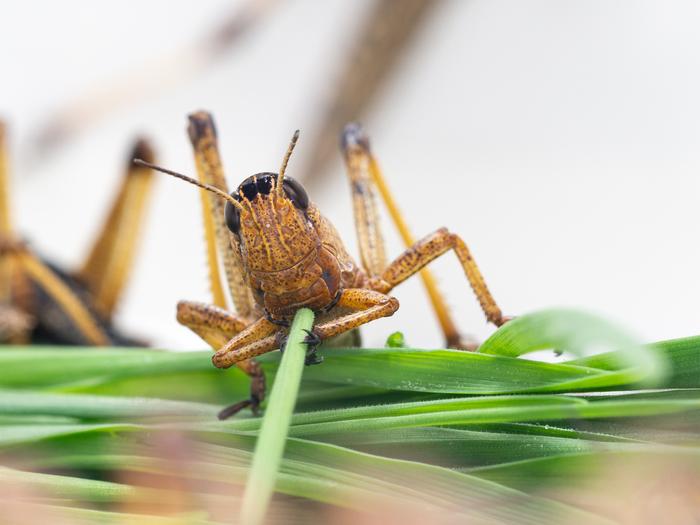The migratory locust Locusta migratoria is an economically important crop pest that is said to have come to Egypt in the Old Testament as the eighth of the ten biblical plagues, “to devour all that plants that grow”. The migratory locust is rarely found in Europe, but in Africa and Asia it not only causes millions of dollars’ worth of damage but also has a deadly impact on local people, threatening their food and their very existence. The locusts occur in two phases: as solitary animals and in swarms. The insects are most feared when they appear in large swarms and destroy entire harvests.

Credit: Benjamin Fabian, Max Planck Institute for Chemical Ecology
The migratory locust Locusta migratoria is an economically important crop pest that is said to have come to Egypt in the Old Testament as the eighth of the ten biblical plagues, “to devour all that plants that grow”. The migratory locust is rarely found in Europe, but in Africa and Asia it not only causes millions of dollars’ worth of damage but also has a deadly impact on local people, threatening their food and their very existence. The locusts occur in two phases: as solitary animals and in swarms. The insects are most feared when they appear in large swarms and destroy entire harvests.
Migratory locusts differ from other insects in the anatomical structure of their olfactory brain, the antennal lobe, which receives and processes olfactory information from the antenna. The locust antennal lobe has a unique and unconventional neuronal architecture with more than 2000 spherical functional olfactory units, the glomeruli, whereas most other insects have only between 20 and 300 glomeruli in the antennal lobe.
Scientists at the Max Planck Institute for Chemical Ecology are interested in how insects perceive odors and process them in their brains. Above all, however, they want to know how odor perception affects their behavior.
“Our goal was to solve the long-standing puzzle of how odors are encoded in the extremely large population of glomeruli, the structural and functional units in the antennal lobe of migratory locusts. This highly complex architecture of the locust antennal lobe has been observed for decades, but the underlying mechanisms of odor coding have remained a mystery due to the lack of suitable methods,” says Xingcong Jiang, first author of the study.
The introduction of the CRISPR/Cas9 method represented a methodological breakthrough for the researchers, as it enabled the establishment of the first transgenic migratory locusts expressing the genetically encoded calcium sensor GCaMP in olfactory sensory neurons. GCaMP is a protein that fluoresces when it binds calcium, which is released into cells when they are active. Using functional 2-photon calcium imaging, the scientists were able to measure and map the spatial activation patterns for a broad spectrum of ecologically relevant odors in all six developmental stages of the migratory locust.
“Our results reveal an unusual functional ring-shaped organization of the antennal lobe consisting of specific glomerular clusters. This glomerular arrangement, which we could confirm by targeted genetic expression of a well-characterized olfactory receptor, is present throughout development, and the pattern of olfactory coding within the glomerular population is consistent at all developmental stages, from the first nymph stage to the adult locust,” summarizes Silke Sachse, head of the Olfactory Coding Research Group at the Max Planck Institute, one of the study leaders.
The migratory locust is not a model organism like the vinegar fly Drosophila melanogaster. Gene transformation was therefore a major challenge for the researchers. Many parameters have to be studied, which makes the process very time-consuming. The unusually large brain volume of the locust also makes it difficult to capture and analyze image data. “We are the first group in the world to successfully apply the site-specific knock-in method to locusts. We know from the literature that the success rate for this type of transgenesis is very low, but we have succeeded,” says Xingcong Jiang.
Interestingly, the spatial coding of odors in the locust antennal lobe reflects the chemical structure of the odors rather than their valence – whether pleasant or repulsive – unlike in flies, for example, where the valence of odors is already represented in the antennal lobe, with pleasant odors activating different structures than unpleasant ones. “We have observed that odors of certain chemical classes evoke a certain pattern: For example, aromatic compounds with similar chemical structure but opposite behavioral significance evoke stronger responses in the peripheral regions of the antennal lobe. We conclude that the representation of odor valence is not encoded in the antennal lobe, but in higher brain centers such as the mushroom body and the lateral horn,” says Bill Hansson, Director of the Department of Evolutionary Neuroethology, and one of the lead authors.
The ring structure of the olfactory code is a unique anatomical feature of the migratory locust. However, this coding mechanism is not necessarily transferable to other locust species. “We wonder whether this ring-shaped structure is a worse alternative or a better solution with advantages over the glomerular arrangement we found in flies. Future studies investigating the rules of odor coding in other insect species will show whether other locust species have developed a similar coding pattern,” says Silke Sachse, who already has further studies in mind.
How insects perceive and process odors and how odor perception ultimately affects their behavior is important for a deeper understanding of the ecological interactions of insects with their environment. This can, for example, help to optimize the control of crop pests such as migratory locusts. “We believe that a better understanding of the odor coding mechanisms in the primary olfactory center of the locust brain will significantly deepen our knowledge of the neuronal modulation underlying olfaction-mediated behaviors, such as the formation of locust swarms,” says Bill Hansson.
Journal
Cell
Method of Research
Experimental study
Subject of Research
Animals
Article Title
Ring-shaped odor coding in the antennal lobe of migratory locusts
Article Publication Date
18-Jun-2024



